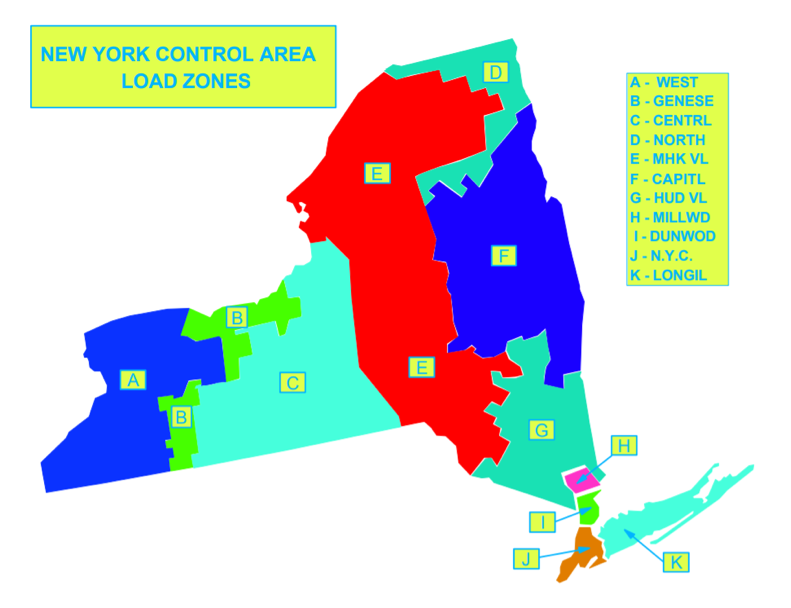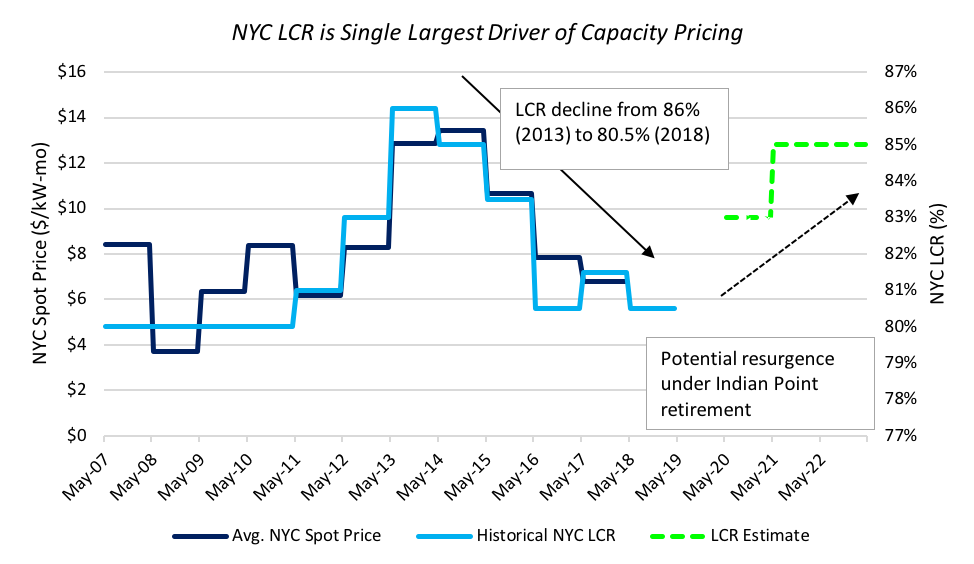
Resurgence in NYC capacity prices possible under new LCR changes
On June 8, the NYISO issued the assumptions and references for its Buyer Side Mitigation Installed Capacity (ICAP) analysis for Class Year 2017-1.
This document contained a surprising assumption: the forecasted Locational Minimum Installed Capacity (LCR) requirement for the New York City locality is 2.5% - 4.5% above its current level of 80.5% in the 2020/2021, 2021/2022, and 2022/2023 capability years (see table below). The higher LCRs are equivalent to approximately 320 MW of demand in 2020 and 550 MW in 2021 and 2022, at the load levels currently forecasted by the NYISO.
The result is bullish for capacity pricing in Zone J—where we believe prices could increase as much as $5-6 per kW-month during summer amounts and up to $1.5 per kW-month in winter months, when the Zone J price is expected to clear at the Lower Hudson Valley price.
While the LCR values are estimates used in the NYISO’s buyer-side mitigation study and not official determinations of the LCRs in those years, the results suggest that a significant increase in the New York City LCR in coming years is a real possibility.
| Capability Year | Zone J | Zone K | Zone G-J Locality |
|---|---|---|---|
| 2020/21 | 83% | 105% | 91% |
| 2021/22 | 85% | 104% | 91.5% |
| 2022/23 | 85% | 104% | 91.5% |
Source: NYISO Buyer Side Mitigation ICAP Forecast – Class Year 2017-1 Assumptions and References, June 8, 2018
LCR Shift Possible Despite New Methodology
The higher LCR comes as a surprise following the NYISO’s filing with FERC this year to revise its methodology for determining LCRs (docket ER18-1743, filed June 5, 2018). Under the proposed “Alternative LCR Methodology,” the LCR for a given locality is less sensitive to changes in capacity within that zone than under the prior methodology, in which the LCR could counterintuitively increase or decrease in response to addition or removal of capacity within the locality.
According to the NYISO, the Alternative LCR Methodology was developed using four guiding principles: “least cost, stable, robust, and predictable.” The new methodology would tend to produce greater stability in the LCR, and fewer shifts such as the BSM forecast suggests, absent structural changes such as new transmission capability or load growth which would enhance or weaken the area’s ability to depend on outside resources.
In this instance, however, the trigger for an increase in LCR is the planned retirement of a plant which is outside of the Zone J (New York City) capacity zone but is nonetheless important to its reliability—the 2 GW Indian Point Energy Center nuclear facility located in Zone H. Although Indian Point is not a Zone J resource, it is located on the New York City side of the UPNY/ConEd transmission interface, which separates zones H, I, J and K (New York City, Long Island and nearby areas) from the rest of the state. With the planned retirement of the two Indian Point units in 2020 and 2021, more power will need to flow through this interface to supply New York City, creating a greater likelihood that the maximum limit of power that can reliably flow through the interface will be reached.
As a result, the projected higher LCR in Zone J appears to reflect an elevated need for capacity to be sited locally in New York City once it can no longer rely on Indian Point, resulting in a higher premium in the capacity market for Zone J resources. Although the retirement of Indian Point was announced in early 2017, the LCR assumptions in the NYISO’s BSM forecast this month are the first formative indication from the market administrator that a major change in LCR would take place as a result.

Source: NYISO
The forecasted increase in LCR due to the Indian Point retirement and the supposed greater stability with respect to changes in generation under the Alternative LCR Methodology appear to be consistent because Indian Point is not located in Zone J and, thus, not a resource that counts towards the NYC locational requirement. In other words, the current Zone J LCR implicitly assumes that Indian Point, located in Zone H, will provide reliability services to NYC and help to maintain the UPNY/ConEd interface uncongested. This implies the potential need for a new zone comprised of load Zones H, I, and J. Were a new locality to go into effect, interconnections positions in Zones H and I would be valued at a premium to Zone G to compensate for the reliability value of resources located downstream of the UPNY/ConEd interface.
Nevertheless, ICF expects that market participants will use this result to challenge the NYISO’s recent section 205 filing at FERC, in which NYISO proposed to modify how the LCRs are set.
Price Impact Positive but Uncertain
The quantitative impact on the NYC capacity price is likely to be significant if the NYISO’s forecasted LCRs materialize, although the magnitude of change depends on the actual LCR values the NYISO determines in its annual process and the decisions of capacity suppliers over the next several years. Assuming no new major entry or retirement decisions in the NYC and Lower Hudson Valley localities (and, assuming as given, the retirement of Indian Point and the entry of the CPV Valley Energy Center, Cricket Valley and Bayonne Energy Center II facilities), summer prices could see a $5-6 per kW-month increase compared to the prior outlook for the 2020/2021, 2021/2022 and 2022/2023 capability years with the new LCRs, bringing prices within the historically high range seen in 2015. Winter NYC prices are more likely to clear with the Lower Hudson Valley capacity zone and may, therefore, see a more reduced impact, but may increase up to $1.5 per kW-month compared to the prior outlook.

While the estimated LCRs are bullish for Zone J capacity pricing, there are numerous factors that could cause the actual LCRs used in the market to differ:
- Static IRM – The NYISO projections assume that the state-wide Installed Reserve Margin (IRM) is fixed at 18.2%. When the NYISO runs the full optimization in its annual process, the optimal solution may favor shifting capacity to rest-of-state, which would increase the IRM and lower the LCRs.
- Final composition of Class Year 2017 – The projections reflect the resource mix and transmission topology of the ongoing Class Year 2017 process. There are more than 5 GW being assessed, and it is reasonable to expect changes in the LCRs as projects drop out of the Class Year.
- Base Case assumptions – The LCR results can be sensitive to changes in load forecast, resource mix, and network topology.
- Fixed net CONE – The NYISO’s Alternative LCR Methodology minimizes the cost of meeting the capacity requirements by increasing the LCRs of the lowest-cost localities. The NYISO Buyer-Side Mitigation study assumed a constant net cost of new entry (CONE) value rather than updating it for annual changes in net energy and ancillary services revenues. The retirement of Indian Point could lead to higher net EA&S revenues for the Zone J and/or Zone G proxy unit, a lower net cost of new entry (CONE), and as a result, a higher Zone J and/or Lower Hudson Valley LCR.
Despite the uncertainties around magnitude, the basic rationale underlying an increase in the NYC LCR—that increased likelihood of congestion on the UPNY/ConEd interface following the Indian Point retirement results in a higher reliability value for resources in Zone J—appears robust. As a result, we view the NYISO forecast as a positive data point for Zone J assets.
The Alternative LCR Methodology is one of several major regulatory changes shaking up the NYISO market. The other prominent regulatory changes include the draft NOx regulations recently released by the New York Department of Environmental Conservation and the NYISO’s and New York State’s joint pursuit of pricing carbon into the wholesale markets.
These three proposals have the potential to dramatically change the outlook for New York generation assets in coming years. Sign up for the ICF Energy Digest for more updates on this evolving topic.